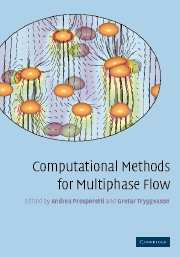Book contents
- Frontmatter
- Contents
- Preface
- Acknowledgments
- 1 Introduction: A computational approach to multiphase flow
- 2 Direct numerical simulations of finite Reynolds number flows
- 3 Immersed boundary methods for fluid interfaces
- 4 Structured grid methods for solid particles
- 5 Finite element methods for particulate flows
- 6 Lattice Boltzmann models for multiphase flows
- 7 Boundary integral methods for Stokes flows
- 8 Averaged equations for multiphase flow
- 9 Point-particle methods for disperse flows
- 10 Segregated methods for two-fluid models
- 11 Coupled methods for multifluid models
- References
- Index
8 - Averaged equations for multiphase flow
Published online by Cambridge University Press: 07 December 2009
- Frontmatter
- Contents
- Preface
- Acknowledgments
- 1 Introduction: A computational approach to multiphase flow
- 2 Direct numerical simulations of finite Reynolds number flows
- 3 Immersed boundary methods for fluid interfaces
- 4 Structured grid methods for solid particles
- 5 Finite element methods for particulate flows
- 6 Lattice Boltzmann models for multiphase flows
- 7 Boundary integral methods for Stokes flows
- 8 Averaged equations for multiphase flow
- 9 Point-particle methods for disperse flows
- 10 Segregated methods for two-fluid models
- 11 Coupled methods for multifluid models
- References
- Index
Summary
The previous chapters have been devoted to methods capable of delivering “numerically exact” solutions of the Navier–Stokes equations as applied to various multiphase flow problems. In spite of their efficiency, these methods still require a substantial amount of computation even for relatively simple cases. It is therefore evident that the simulation of more complex flows approaching those encountered in most natural situations or technological contexts (sediment transport, fluidized beds, electric power generation, and many others) cannot be pursued by those means but must be based on a different approach. Furthermore, even if we did have detailed knowledge, e.g., of the motion of all the particles and of the interstitial fluid, most often, for practical purposes, we would be interested in quantities obtained by applying some sort of averaging to this immense amount of information. This observation suggests that it might be advantageous to attempt to formulate equations governing the time evolution of these averages directly. In this approach, rather than aiming at a detailed solution of the Navier–Stokes equations, we would be satisfied with a reduced description based on simplified mathematical models. While one may try to base such models on intuition, a more reliable way is perhaps to start from the exact equations and carry out a process of averaging which would filter out the inessential details retaining the basic physical processes which determine the behavior of the system.
Introduction
The issue of averaging in multiphase flow is a long-standing one with a history which stretches nearly as far back as for single-phase turbulence.
- Type
- Chapter
- Information
- Computational Methods for Multiphase Flow , pp. 237 - 281Publisher: Cambridge University PressPrint publication year: 2007
- 2
- Cited by



